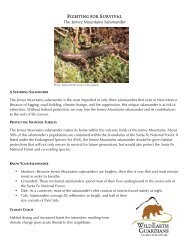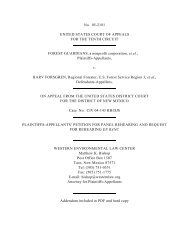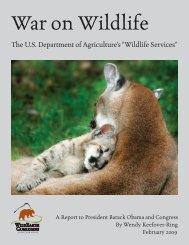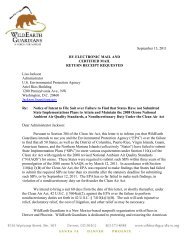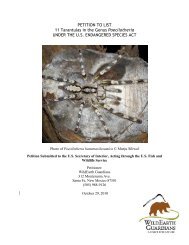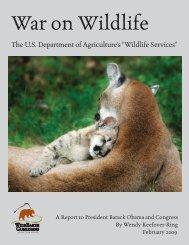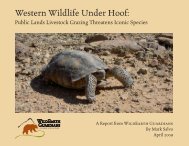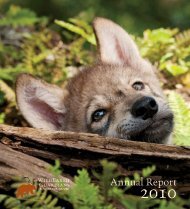PETITION TO LIST THE JEMEZ MOUNTAINS SALAMANDER ...
PETITION TO LIST THE JEMEZ MOUNTAINS SALAMANDER ...
PETITION TO LIST THE JEMEZ MOUNTAINS SALAMANDER ...
Create successful ePaper yourself
Turn your PDF publications into a flip-book with our unique Google optimized e-Paper software.
WildEarth Guardians Petition to List<br />
Jemez Mountains Salamander Under the ESA<br />
17<br />
2003c). Scientists have found that salvage logging poses significant ecological harms and<br />
can be quite harmful to amphibians (Corn and Bury 1999; DellaSala 2006; Reeves et al.<br />
2006).<br />
Roads create an extensive separation barrier for this species by fragmenting the habitat.<br />
Habitat fragmentation makes immigration and emigration to and from suitable and<br />
unsuitable habitat difficult if not impossible for this species (NatureServe 2006). As<br />
stated previously, the separation distance for the Jemez Mountains salamander within<br />
suitable habitat is 3 km, whereas, within unsuitable habitat the separation distance<br />
decreases to 1 km. Travel within unsuitable habitat is so difficult for this salamander that<br />
the actual separation distance may be measured in meters. Fragmentation greatly reduces<br />
the ability of this species, which already exists in six isolated areas, to persist. This is<br />
especially true if habitat in one of the six Essential Zones becomes degraded.<br />
Whereas pumice mining in Jemez Mountains salamander habitat is not a direct threat,<br />
associated haul roads and other support activity adversely affect individuals (NMEST<br />
2000b). Dams can also destroy suitable habitat, by use of heavy machinery and can<br />
result in flooding of suitable terrestrial habitat (NMEST 2002c).<br />
Chemical use within the Jemez Mountains salamander habitat can create a caustic<br />
environment within soil matrixes. Fire retardant is used to suppress wildfires. Until<br />
2004, the USFS allowed fire retardant to be used that was known to contain levels of<br />
cyanide lethal to fish. Millions of gallons of retardant are applied annually nationwide.<br />
For example, during 2006, 31.3 million gallons of retardant were applied. 2 Fire<br />
suppression can therefore have a toxic effect on the Petitioned species.<br />
In addition, insecticides are used in the forest to prevent tree loss and can cause harm to<br />
the microenvironment of the salamander. The New Mexico Department of Game and<br />
Fish (NMDGF 1988) stated that “Tree loss due to disease may also contribute to the<br />
problem of habitat degradation, although the spraying of toxic chemicals to prevent this<br />
can be equally as threatening to these salamanders.”<br />
Predation<br />
The only observed predator of adult Jemez Mountains salamanders, is the western garter<br />
snake (Thamnophis elegans) (Degenhardt et al. 1996). This snake is found to be<br />
abundant in the habitat of P. neomexicanus and may often prey on this salamander.<br />
Disease<br />
One the biggest threats facing amphibians world-wide is the disease Chytridiomycosis,<br />
caused by the chytrid fungus (Batrachochytrium dendrobatidis) (Carey et al. 2003). The<br />
fungus can cause sporadic deaths in some amphibian populations and 100% mortality in<br />
others. In the past 15 years, this disease has been implicated in the mass die-offs and<br />
2 U.S. Forest Service. 2007. Environmental assessment for aerial application of fire retardant. Released<br />
October 2007. Available at: http://www.fs.fed.us/fire/retardant/index.html.



